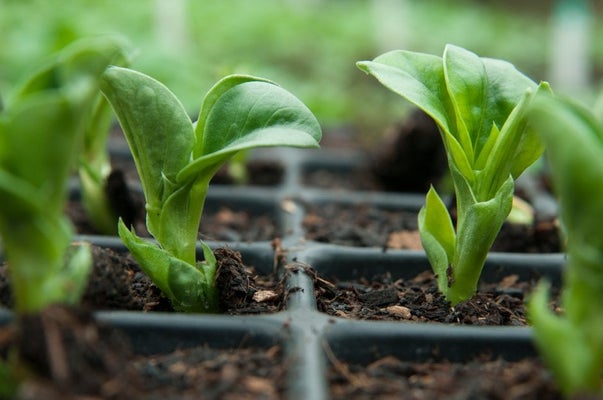
Quick facts
Plants have growing zones, called meristems, in their stems and roots. Some create upward growth, making stems and roots longer, and some create outward growth, increasing girth
Most plants grow from their tips, although grass-like plants grow from a meristem at their base
We can use practices like pruning, pinching out and mowing to deliberately alter the growth of a plant to suit our garden
The process of growth
Growth occurs when cells divide, differentiate (become specialised to a particular function) and elongate. In plants, this occurs in growing zones called and is controlled by three : , and .
The meristems in shoot and root tips are responsible for making a plant taller and longer, which allows leaves to reach sunlight and roots to spread out through the soil.
The meristems found inside stems and roots are responsible for making a plant wider and thicker, which ensures it can support the weight of its leaves, flowers and fruit.
How stems grow taller
In most plants, growth happens at the terminal (apical) at the tip of their stems. This bud produces that suppress growth from any other (axillary) lower down on the stem, in a process called .
Buds contain and a concentration of , which gives them growth potential if the part of the stem beyond them gets damaged. So, if the apical bud is removed, axillary buds are stimulated into growth.
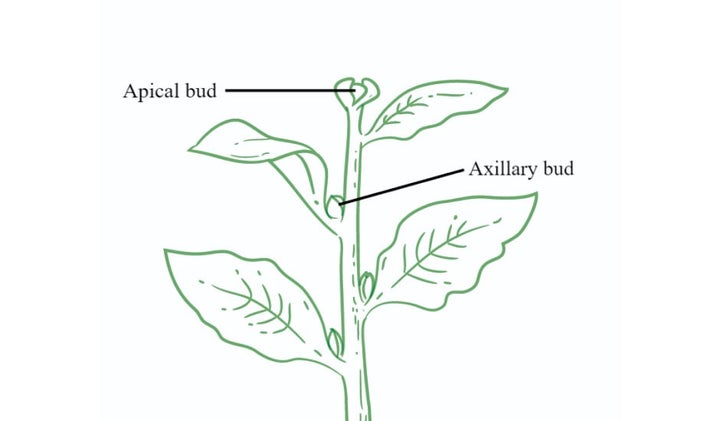
You can use this knowledge to produce bushier, more productive plants:

Pinching out the shoot tips of young plants stimulates them to produce more side-shoots bearing lots of flowers. This technique is used to get the best from summer bedding plants like fuchsias and sweet peas.

Hedge trimming removes shoot tips, encouraging plants to branch and increasing the density of the hedge. This not only offers better screening and security, but also traps more air pollution and reduces noise levels.

Hard pruning shrubs, such as dogwoods and willows, removes most of the top growth and dominant buds. This allows dormant buds at the base to sprout into growth and produce a flush of colourful new stems.
Did you know?
Palms don’t have buds along their stems, so if their growing tip is removed, they can’t produce replacement side-shoots and are likely to die.
Grasses and grass-like plants have their active growing zone ( ) at their base rather than the tip. This means that when you mow your lawn, cutting off the leaf tips, the grass can continue to grow.
How stems grow thicker
As plants grow, their stems get thicker and sturdier to provide support. Soft green shoots gradually become woody and less flexible and tree trunks increase in girth.
This thickening is produced by a , called cambium tissue, found inside stems. Its dividing cells produce more (secondary) and (tube-like transportation vessels) as stems grow and need more resources.
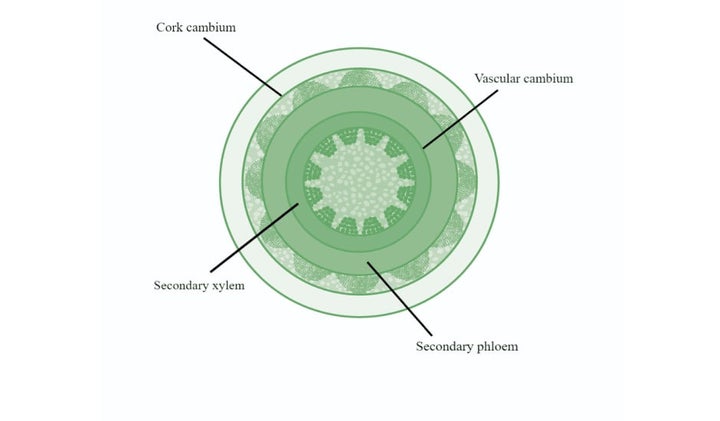
In green stems, cambium is spread through the tissue in bundles sandwiched between the xylem and phloem. In woody stems, over time, these join to become rings of tissue. This is sapwood, a soft outer layer lying between the inner heartwood and the .
made in spring carry more water up from the roots than those made in summer and autumn, so spring sapwood is lighter in colour. A distinct line forms each year where the two tissues meet, and by counting the 'tree rings', it’s possible to estimate the age of a tree.

Trunk girth is also a useful indication of age. If you buy a young tree from a nursery, you’ll often find that the circumference of the trunk at 1m (3¼ft) in height is provided, to indicate the tree’s maturity and define its price.
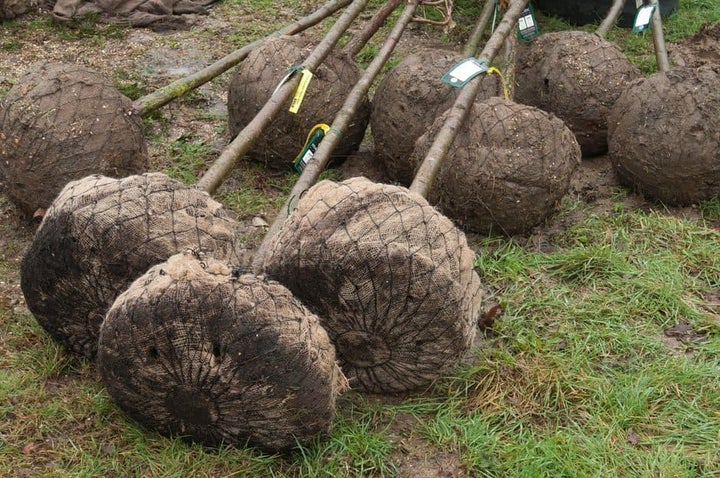
Bark, the protective outer layer on woody stems (and roots), is produced by another meristem, the cork cambium. Bark is several cells thick and is continually renewed by the cork cambium as the outer layer dries and cracks.
Did you know?
Different trees have their own unique bark patterns and colours. Many, like silver birches (Betula pendula) and paper-bark maples (Acer griseum) have very decorative bark, adding interest to our gardens.
How roots grow
Roots grow into the soil searching for and water between soil particles. A root’s growing tip (apical ) and elongation zone sit behind a protective sheath, the root cap.
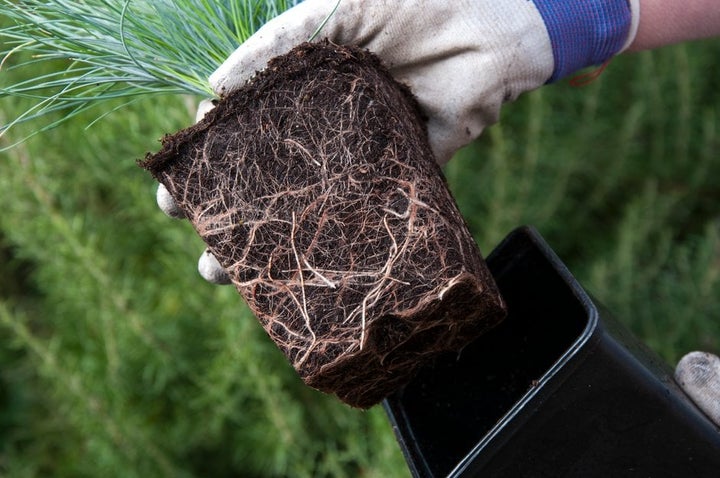
There are two types of roots:
Tap roots naturally grow straight downwards to seek out water and nutrients deep in the soil. They provide good anchorage and are often thickened with stored starch. In many trees, the tap root fades away over time as other roots develop.
As tap-rooted plants don’t transplant well, are hard to grow in containers and have fewer fine roots for water absorption, many tree nurseries undercut young trees, severing their tap root, to encourage more fibrous root growth. This makes them easier to manage and reduces transplant shock.
Fibrous roots form a fine, branching network with a large surface area for absorption. They are found just below the soil surface and collect water and nutrients percolating through the soil.
Around 90% of tree roots are found in the top 60cm (2ft) of soil, and as fibrous roots are easily damaged, it’s important not to compact this rootzone area, for example by parking cars under a tree’s canopy.

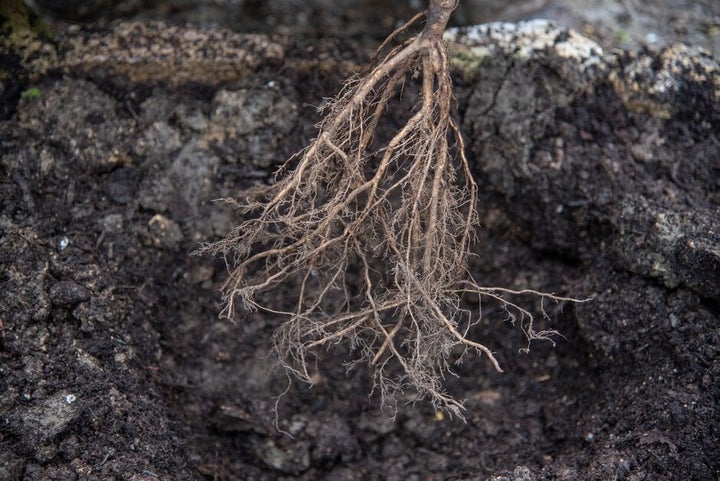
Roots initiate branching internally, from an area around their central core where their ( and ) is, rather than from external like stems do. These branches grow at right angles to the parent root, to better explore the soil, and are exact copies of it, with their own ability to branch further.
As a plant grows, it keeps in balance the parts that make energy through sunlight (the green growth) and the parts that take up water and nutrients to feed it (the root network). Lifting a plant damages the fine feeder roots that absorb these key ingredients. That’s why cutting back top growth when you move plants can help restore the balance and ensure they settle into their new home well.
Your next steps
Now you know more about how plants grow, put this into practice to help your plants thrive:
- the tips of summer to improve their flowering display. Also see our guide to bedding plants
- Trim hedges regularly to increase their density. Most hedges benefit from trimming once or twice during the growing season
- Consider trunk diameter and look for a balanced ratio of roots to shoots when you next buy a tree – the thickness of the trunkgives you an idea of its age, which is useful when comparing prices, and a well-balanced tree should establish better. See our guide to buying trees
- Avoid moving plants with a , as they have fewer fine feeder roots and often don't recover well if disturbed. This includes edibles like carrots, parsnips and dill, which are best sown in situ, and like sea holly (Eryngium) and oriental poppies (Papaver orientale)
- Loosen the soil at the edges of a planting hole to make it easier for roots to grow and branch. See our step-by-step guide to planting a tree







